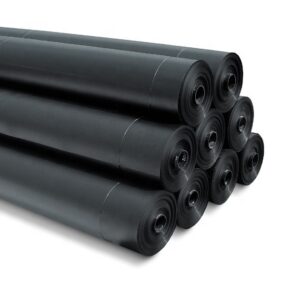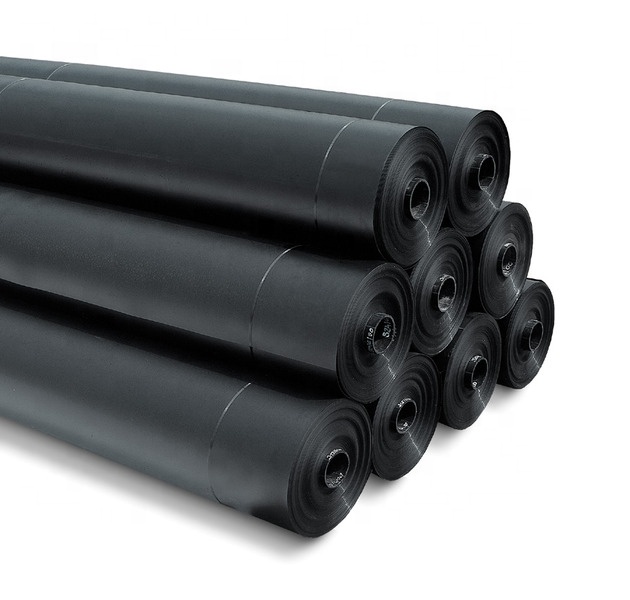Geomembrane elongation at break test
The elongation at break test of geomembranes is a test method used to evaluate the tensile properties of geomembrane materials. This test is often used to determine how much stretch a geomembrane can withstand when a force is applied, and how far it can stretch during the stretching process.
The following are the general steps and methods for conducting geomembrane elongation at break testing:
Sample preparation: Cut representative specimens from the geomembrane. The shape and size of the specimen is usually determined by the specific testing standard or project requirements. Standard specimens are usually rectangular in shape, with standard length and width.
Testing equipment: Use a universal testing machine, a device used to measure the mechanical properties of materials. Tensile testing machines are capable of applying uniform tensile force and measuring the deformation of the specimen.
Test condition setting: Set appropriate test parameters on the tensile testing machine, including tensile speed, test temperature (if necessary), etc. These parameters are usually determined based on relevant standards or specifications.
Sample installation: Clamp the geomembrane sample between the clamps of the tensile testing machine to ensure that the sample is stretched evenly.
Apply tensile force: Start the tensile testing machine and apply uniform tensile force to the specimen until the specimen breaks. During the stretching process, the testing machine records the tensile force and the elongation of the sample in real time.
Data recording and analysis: During the test, the tensile testing machine records the tensile force and elongation of the sample. After the test is completed, the data can be used to calculate the elongation at break. Elongation at break is usually expressed as a percentage and is calculated as:
[ \text{Elongation at break} = \frac{\text{Elongation at break}}{\text{Original length}} \times 100% ]
Data Analysis and Reporting: Analyze test results and compare the elongation at break of the geomembrane to the requirements of the standard or project requirements. Record the test results in the test report for subsequent reference and analysis.
It is important to note that specific geomembrane elongation at break test methods and standards may vary depending on application needs, geomembrane type and project requirements.
Therefore, before conducting testing, it is recommended to refer to relevant standards, specifications or project requirements to ensure the accuracy and consistency of the testing process.

Geomembrane gas permeability testing
The gas permeability test of geomembranes is a test method used to evaluate the ability of geomembrane materials to penetrate gases. This test is commonly used to determine whether geomembranes are effective in preventing the penetration of gases such as methane and carbon dioxide in various applications such as landfills, wastewater treatment plants and ponds.
The following are the general steps and methods for conducting geomembrane gas permeability testing:
Sample preparation: Cut a representative sample from the geomembrane. The shape and size of the sample is usually determined by the specific testing standard or project requirements.
Testing equipment: Use gas permeability testing equipment, such as a permeameter or gas permeability testing equipment. These devices typically include a gas source, test chamber for geomembrane samples, pressure measurement devices, and gas flow controllers.
Sample installation: Install the geomembrane sample in the testing equipment, ensuring a good seal to prevent gas leakage.
Gas flow and pressure control: Introduce the desired gas (such as methane or carbon dioxide) into the test chamber while controlling the gas flow and pressure. This will simulate the gas pressure that the geomembrane will be exposed to in actual applications.
Test duration: The duration of the test can vary depending on the specific requirements, usually ranging from hours to days. The length of the test depends on the simulated usage scenario and the test criteria.
Gas permeability measurement: Evaluate the gas permeability of a geomembrane by measuring its gas permeability through a certain period of time. Permeability is usually expressed as the ratio of the volume of gas flowing per unit time to the pressure difference.
Data recording and analysis: Record the gas permeability data during the test and perform data analysis. Compare test results to specifications or project requirements to determine the performance of the geomembrane in terms of gas permeation.
It is important to note that specific geomembrane gas permeability testing methods and standards may vary depending on application needs, geomembrane type and project requirements.
Therefore, before conducting testing, it is recommended to refer to relevant standards, specifications or project requirements to ensure the accuracy and consistency of the testing process.
Test results can help determine the geomembrane’s performance in preventing gas penetration to ensure its effectiveness in a specific application.

Geomembrane mass density test
Mass density testing of geomembranes is a common method to evaluate their physical performance and quality characteristics. Mass density refers to the mass per unit volume and can help determine the compactness and material quality of the geomembrane.
The following are the general steps and methods for geomembrane mass density testing:
Sample preparation: Cut a representative sample from the geomembrane. The shape and size of the sample is usually based on specific standards or project needs.
Weighing: Using an accurate balance or weighing equipment, weigh the geomembrane sample. Ensure accurate documentation of geomembrane quality.
Volume Measurement: Determine the exact volume of a geomembrane sample. This can be done by methods such as water immersion, oil immersion or exhaust. The specific choice depends on the nature of the geomembrane material and the actual situation.
Calculate mass density: Calculate the mass density of a geomembrane by dividing its mass by its volume. The formula for calculating mass density is: mass density = mass/volume.
Record and analyze data: Record test results and conduct data analysis. This will help evaluate the mass density of the geomembrane and compare it to specifications or project requirements.
It is important to note that specific geomembrane mass density testing methods and standards may vary depending on application needs, geomembrane material type and project requirements.
Therefore, before conducting testing, it is recommended to refer to relevant standards, specifications or project requirements to ensure the accuracy and consistency of the testing process.
Test results can help determine the quality characteristics of the geomembrane to select the appropriate geomembrane material to meet specific needs.
Author

Founded in 2002, Tinhy's team focuses on the manufacturing, marketing, installation, application and research and development of geosynthetic materials.
View all posts






